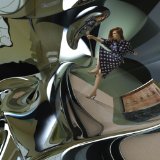 Glasser’s second full-length album is less touchy-feely than her indie electro 2011 debut, the wondrously rich and textured “Ring”. With lead singer Cameron Mesirow now cast as a high glamour, high concept academic, ‘”Interiors” is Glasser’s attempt to interpret human experiences with man-made environments, structures like New York’s Guggenheim maybe, and channel them into predominantly man-made music. It’s not as labour intensive as it sounds and on the whole is not a difficult album to listen to; it’s certainly more aloof than her previous work but concessions to a more nurturing and familiar sound do finally rise to the top. There is also a triptych of songs about windows.
Glasser’s second full-length album is less touchy-feely than her indie electro 2011 debut, the wondrously rich and textured “Ring”. With lead singer Cameron Mesirow now cast as a high glamour, high concept academic, ‘”Interiors” is Glasser’s attempt to interpret human experiences with man-made environments, structures like New York’s Guggenheim maybe, and channel them into predominantly man-made music. It’s not as labour intensive as it sounds and on the whole is not a difficult album to listen to; it’s certainly more aloof than her previous work but concessions to a more nurturing and familiar sound do finally rise to the top. There is also a triptych of songs about windows.
“Shape” opens up with languid, humming synths and swaying coos. It’s eerie but not alienating and is Glasser’s starting point before she reaches beyond her imagined comfort zone ‘I live on the beach, water surrounding me, and it’s got too deep …my home has no shape, nothing to sustain me, but it keeps me safe from imagined pain’. “Design” calls to mind Roisin Murphy’s work with Mathew Herbert in its vocal tics and sounds of machines trying to represent nature and design and the seductive use of strings and sliding synth effects on “Landscape” provoke and engage. “Keam Theme”, the one true dancer here, uses midtempo house beats and hi-hats and although Bjork references come far too easy (the similarities between this and “Vespertine” are numerous) it’s hard not to think of “Hyperballad” as its older, more street smart, sister.
The aforementioned “Window i” with its gentle pads and clicks is intimate but hollow and “Window iii” and “Window ii” (in that order) are both short and serve more as interludes but they are also redundant here. The promised visuals that are due to accompany the upcoming tour may help to explain their presence but, unaccompanied at least, it’s a minor experimental indulgence. More positively they also usher in the album’s recurring use of Cantonese mandolins which, along with saxophone, helps inject the steely soundscapes with human touches. Far-eastern musical influences were also heard in “Ring” but the tribal and more harmonious and inclusive sound of that collection is almost entirely absent from “Interiors”. The slower songs towards the album’s end are quite lovely though, “New Year” in particular has a surprisingly romantic and old fashioned melody with a traditional song structure and is in direct opposition to the somewhat lonely sounding, shiny and self-contained first half.
Glasser has made an album that positions her among the more experimental art-pop genre of electronic artists such as Julia Holter and Laurel Halo, it actually sees her sitting precariously between these two specific artists; the surreal, lyrical nature of Holter meets the electronic forward thinking soundscape obsessions of Halo. “Interiors”, however, falls short of its aims and ultimately doesn’t become the original and career-defining album that it could have been; the material is not consistently strong enough to permit this. Glasser will no doubt bring this music to life over the next year or so with touring and a continuation of the already captivating visuals we’ve seen with the ‘”Design” video and this is something to look forward to. The more intriguing prospect though will be where will Glasser go next; an exciting artist with her best material to come.


